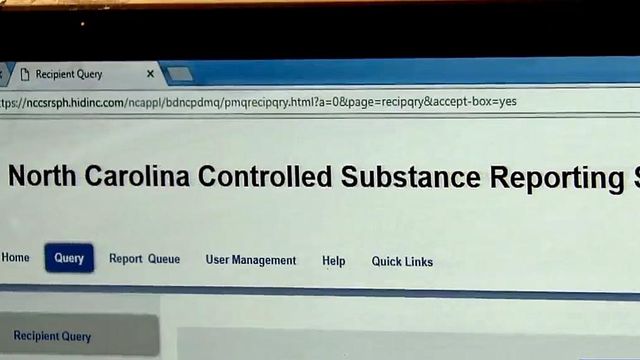Despite new law, NC prescription database used by 1 in 4 doctors
Some experts call a statewide prescription database the single greatest tool for combating the growing opioid epidemic in North Carolina, but a WRAL investigation found that fewer than one in four doctors use it.
The STOP Act, signed by Gov. Roy Cooper in July, requires doctors, dentists, veterinarians and pharmacists to track prescriptions for controlled substances in schedules II through V, including opioid pain medications, through the state’s Controlled Substances Reporting System database.
The database shows a patient's opioid prescription history.
Improper reporting would carry a civil penalty.
But in North Carolina, despite the law, the tool may not be fully deployed for years.
Dr. Scott Kirby, with the state medical board, called the technology a game-changer.
"I think it’s the single best tool to provide objective evidence about what the patient is receiving from other prescribers or what their risk factors are for the potential for abuse, diversion and overdose," he said.
A 2011 WRAL Investigation found 26 percent of prescribers were voluntarily registered, and while the number has steadily increased, it’s currently at 60 percent, fewer than 25 percent of prescribers say they actively use it.
Emergency room Dr. Abhi Mehrotra is one who does, but he says the process, which can take up to 5 minutes per patient, costs him time.
"In order to check the system I have to go to the website, log in, enter specifically the patient’s data, date of birth, zip code and how long I want to check it for, then wait for the system to come back," he said. "Then go and click into the report, print that off and then I have it available."
"When it’s appropriate, I'll choose to use it," he said.
The vast majority of prescribers in North Carolina do not utilize the database, many blaming the time-consuming process.
The Department of Health and Human Services says it wants to finish system upgrades before making it mandatory, but that could take two years.
"One of the major initiatives across our state right now is educating providers on many things, one is safe opioid prescribing and things like CDC guidelines, part of that is also making sure they’re educated on how to use CSRS and knowing that they can use that," said Dr. Susan Kansagra with DHHS.
Experts agree that the technology could prevent so-called doctor shopping and the escalation of addiction in patients like Jacob Ocker.
The Air Force left Ocker with scars on his face, neck and arms. He was prescribed painkillers, but then was left with an addiction he couldn't kick.
"Whatever I could find, I'd take oxycodone. Two or three of them, four times a day," he said.
When his doctor retired, he found another.
Ocker turned to stronger opioids, and when they didn't touch his pain anymore, he began using street drugs.
"I'd want to get off of it and just go to the doctor and take pain medicine is all I wanted to do," he said. "I think there's a lot of people using them because they like the feeling of them, not necessarily using them for what they're intended for."
Experts say improvements to the database will include a more user-friendly interface, a visual list of medications and integrating the database with the state's electronic health records.












